#e1ece2 Color Information
In a RGB color space, hex #e1ece2 is composed of 88.2% red, 92.5% green and 88.6% blue. Whereas in a CMYK color space, it is composed of 4.7% cyan, 0% magenta, 4.2% yellow and 7.5% black. It has a hue angle of 125.5 degrees, a saturation of 22.4% and a lightness of 90.4%. #e1ece2 color hex could be obtained by blending #ffffff with #c3d9c5. Closest websafe color is: #ccffcc.
-
- R 88
- G 93
- B 89
-
- C 5
- M 0
- Y 4
- K 7
● #e1ece2 color description : Light grayish lime green.
#e1ece2 Color Conversion
The hexadecimal color #e1ece2 has RGB values of R:225, G:236, B:226 and CMYK values of C:0.05, M:0, Y:0.04, K:0.07. Its decimal value is 14806242.
| Hex triplet | e1ece2 | #e1ece2 |
|---|---|---|
| RGB Decimal | 225, 236, 226 | rgb(225,236,226) |
| RGB Percent | 88.2, 92.5, 88.6 | rgb(88.2%,92.5%,88.6%) |
| CMYK | 5, 0, 4, 7 | |
| HSL | 125.5°, 22.4, 90.4 | hsl(125.5,22.4%,90.4%) |
| HSV (or HSB) | 125.5°, 4.7, 92.5 | |
| Web Safe | ccffcc | #ccffcc |
| CIE-LAB | 92.349, -5.453, 3.57 |
|---|---|
| XYZ | 74.772, 81.489, 83.737 |
| xyY | 0.312, 0.34, 81.489 |
| CIE-LCH | 92.349, 6.518, 146.784 |
| CIE-LUV | 92.349, -5.608, 6.411 |
| Hunter-Lab | 90.271, -10.123, 8.192 |
| Binary | 11100001, 11101100, 11100010 |
Color Schemes with #e1ece2
Alternatives to #e1ece2
Below, you can see some colors close to #e1ece2. Having a set of related colors can be useful if you need an inspirational alternative to your original color choice.
#e1ece2 Preview
This text has a font color of #e1ece2.
<span style="color:#e1ece2;">Text here</span>This paragraph has a background color of #e1ece2.
<p style="background-color:#e1ece2;">Content here</p>This element has a border color of #e1ece2.
<div style="border:1px solid #e1ece2;">Content here</div>.text {color:#e1ece2;}.background {background-color:#e1ece2;}.border {border:1px solid #e1ece2;}Shades and Tints of #e1ece2
A shade is achieved by adding black to any pure hue, while a tint is created by mixing white to any pure color. In this example, #040604 is the darkest color, while #f9fbf9 is the lightest one.
-
#040604
#040604rgb(4,6,4) -
#0b120c
#0b120crgb(11,18,12) -
#131e14
#131e14rgb(19,30,20) -
#1b2a1c
#1b2a1crgb(27,42,28) -
#223624
#223624rgb(34,54,36) -
#2a422c
#2a422crgb(42,66,44) -
#314e34
#314e34rgb(49,78,52) -
#395a3c
#395a3crgb(57,90,60) -
#416644
#416644rgb(65,102,68) -
#48724c
#48724crgb(72,114,76) -
#507e54
#507e54rgb(80,126,84) -
#578a5c
#578a5crgb(87,138,92) -
#5f9664
#5f9664rgb(95,150,100)
-
#69a06e
#69a06ergb(105,160,110) -
#75a87a
#75a87argb(117,168,122) -
#81af85
#81af85rgb(129,175,133) -
#8db791
#8db791rgb(141,183,145) -
#99be9c
#99be9crgb(153,190,156) -
#a5c6a8
#a5c6a8rgb(165,198,168) -
#b1ceb4
#b1ceb4rgb(177,206,180) -
#bdd5bf
#bdd5bfrgb(189,213,191) -
#c9ddcb
#c9ddcbrgb(201,221,203) -
#d5e4d6
#d5e4d6rgb(213,228,214) -
#e1ece2
#e1ece2rgb(225,236,226) -
#edf4ee
#edf4eergb(237,244,238) -
#f9fbf9
#f9fbf9rgb(249,251,249)
Tones of #e1ece2
A tone is produced by adding gray to any pure hue. In this case, #e5e8e5 is the less saturated color, while #ceffd3 is the most saturated one.
-
#e5e8e5
#e5e8e5rgb(229,232,229) -
#e3eae4
#e3eae4rgb(227,234,228) -
#e1ece2
#e1ece2rgb(225,236,226) -
#dfeee0
#dfeee0rgb(223,238,224) -
#ddf0df
#ddf0dfrgb(221,240,223) -
#dbf2dd
#dbf2ddrgb(219,242,221) -
#d9f4dc
#d9f4dcrgb(217,244,220) -
#d8f5da
#d8f5dargb(216,245,218) -
#d6f7d9
#d6f7d9rgb(214,247,217) -
#d4f9d7
#d4f9d7rgb(212,249,215) -
#d2fbd6
#d2fbd6rgb(210,251,214) -
#d0fdd4
#d0fdd4rgb(208,253,212) -
#ceffd3
#ceffd3rgb(206,255,211)
Color Blindness Simulator
Below, you can see how #e1ece2 is perceived by people affected by a color vision deficiency. This can be useful if you need to ensure your color combinations are accessible to color-blind users.
